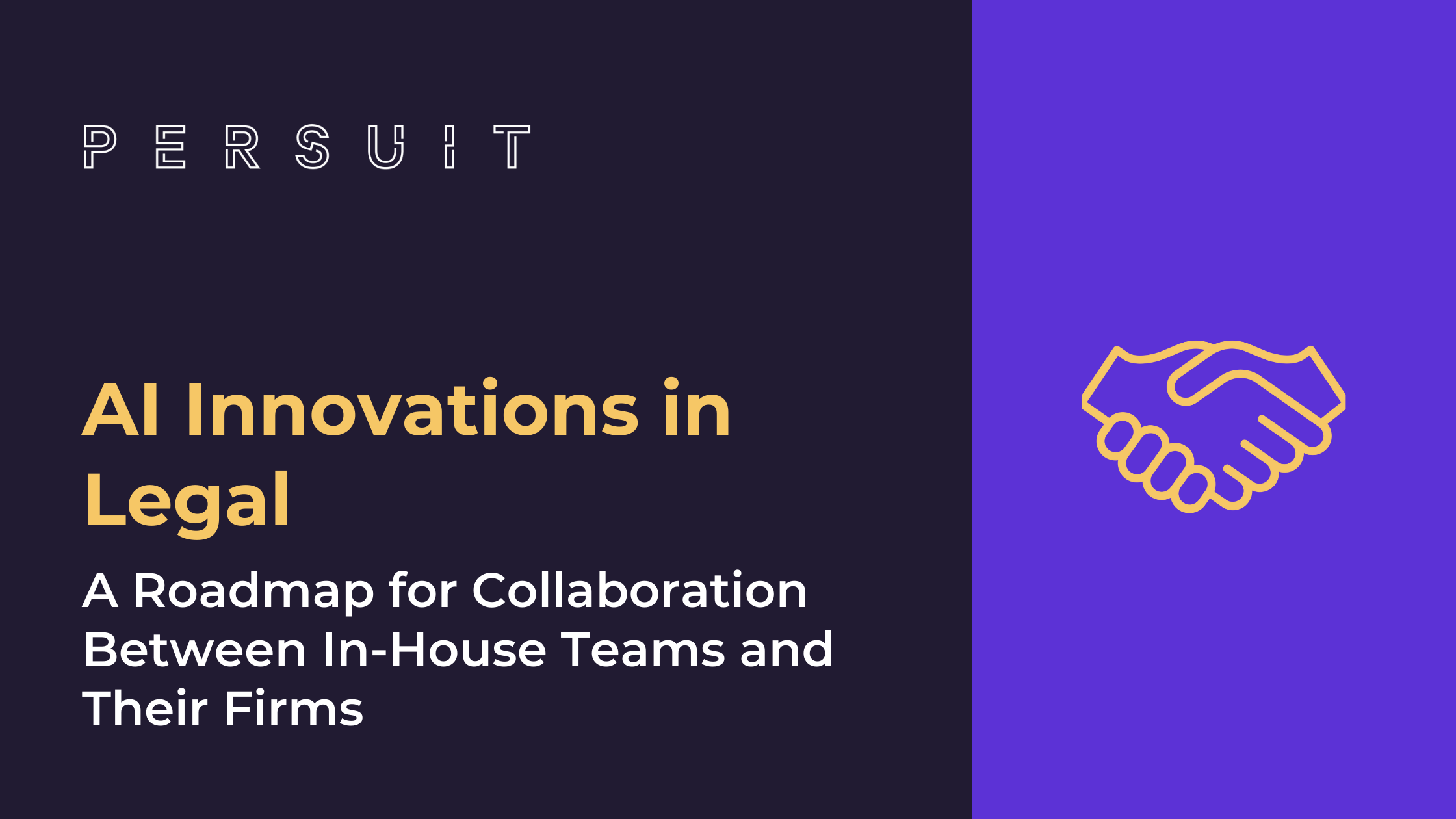
Artificial Intelligence (AI) and more specifically Large Language Models (LLM) and Generative AI (GenAI) are rapidly transforming the legal industry.
But as the ChatGPT hype begins to fade, in-house teams are finding that there’s a lot of work to leverage the promised “magic” that lies behind this (not so) new technology.
Last month, I hosted a spectacular panel of industry experts to share their experiences and predictions about how generative AI is transforming the in-house/firm relationship and the billable hours model in legal, including:
- Chris Grant, Head of Legal Market Engagement at HSBC
- David Cunningham, Chief Innovation Officer at Reed Smith, and
- Sean Monahan, Senior Director of Data Modernization at HBR Consulting.
In this article, I’ve pulled some of the key takeaways and highlights.
Note: The webinar replay is available in PERSUIT’s resources area. You can watch the full video here.
Legal teams are over the ChatGPT hype
Legal teams have quickly found themselves moving past the ChatGPT hype and entering what Sean Monahan calls “the trough of despair.”
"Pilot use cases aren’t getting teams where they need to go."
The gains to be had with simpler applications have already been made with other tools, automation, and outsourcing. And as teams start to try and apply generative AI solutions to more sophisticated activities, they are finding challenges around securing buy-in, resources, training, and simply understanding what these potential use cases are.
Firms are well-placed to lead collaborative efforts with their clients and in-house teams should be asking for their help.
Here, Sean gives a quick rundown of legal teams’ current thinking around these challenges. And how outside counsel plays an increasingly important role for in-house teams looking to overcome them:
Many in-house teams might be overlooking their most important AI resource
We polled our webinar participants about their current level of collaboration with their respective client or firm partners on Generative AI-related initiatives.
Shockingly, only 8.5% of the 100+ attendees who responded said that they are currently collaborating on Generative AI-related initiatives.
As Chris Grant explained, corporate teams like HSBC’s are looking for support and expertise from their firms on GenAI collaborations: “It’s not something that we’ll deliver on our own, and hopefully doing it all together means we get somewhere faster.”
How in-house and outside counsel collaborate here might also look different depending on the size and capabilities of the organization. As David Cunningham explained:
"Who's got the right resources to do this well? For some companies, they may do more in-house and some others may say, 'Hey, lean on your law firms more.' The more integrated we are to the tool sets, the data flow, the processes, the roles, the more helpful we are to the client."
What are some of the most promising use cases for GenAI in legal?
David, Sean, and Chris all shared several compelling use cases for GenAI and LLMs, including:
- “Four corners” applications where LLMs can query a specific document that is already known and trusted to be accurate, like a particular policy or contract.
- Monitoring and summarizing regulatory developments and changes.
- Private instances of ChatGPT that permit your talent to use LLMs more creatively and develop their own use cases.
- Helping teams more effectively manage legal spend by analyzing litigation risks and probable outcomes.
As Sean pointed out, the buzz around GenAI and LLMs is also a great opportunity to introduce old tools and capabilities in a new context and get others excited about using or adopting them more effectively.
Will AI kill firm profitability?
Not at all. In fact, just the opposite.
As Chris shared, from HSBC’s perspective:
"Just because you put AI in place doesn't mean I won't pay the same price as I was paying before because you are doing it quicker and faster.
In fact, I might pay a premium because you're doing it little bit quicker. But that conversation won’t be had if we’re talking about the hourly rate."
By moving away from the “chain of the hourly rate,” firms can increase efficiencies, pick up more work, and better service their clients, which all ultimately lead to more profitability.
How can in-house teams better collaborate with their firms?
Firms are generally a bit further ahead, so it’s implicit on them to proactively talk with their corporate counsel partners about opportunities to test new ideas.
But ultimately, it’s corporate clients who control the pace of change.
As David explained it best: “I would urge the other 92% (of those polled today). Get out there and, and that makes the change happen. Reach out to the partner you work with. I would say do it because that's the only way things change.”
"That's why diversity programs happen. That's why billing changes. That's why fixed fees happen. That's the way innovation happens.
And so you as a client calling a law firm and saying, this is a priority to me. What are you gonna do about it? That’s what gets budgets committed. That's what gets people hired. That's what puts people in the hot seat."
Download our free guide, produced in collaboration with our webinar guests, on how to start the conversation about AI with your firms.
A full replay of the 60-minute webinar with Chris, David, and Sean is also available for free in our resources area.
